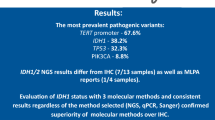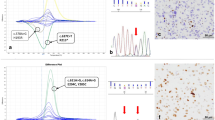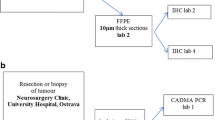Abstract
The WHO2016 CNS update requires a combined histological and molecular assessment. To assess the major aberrations such as co-deletion of complete chromosome arms 1p and 19q (Co-del), isocitrate dehydrogenase and histone H3 mutations, direct sequencing, multiplex ligation-dependent probe amplification and/or FISH are methods considered to be “golden standard” in the community. However, these methods are expensive and complicated. The aim of this study is verification of the sensitivity of the simple PCR-based techniques for assessment of molecular information in daily diagnosis. We analyzed a total number of 80 patients with gliomas. FISH and PCR-based microsatellite analysis were compared for Co-del assessment. Direct sequencing and qPCR using hig-resolution melting (HRM) were compared for IDH and histone H3 mutations. The sensitivity and specificity of FISH were 0.71 and 0.79, respectively. FISH using a commercially available Vysis probe had a risk of high false-positive rate (0.25). For assessment of IDH1 mutations, the sensitivity and specificity of HRM were 1.0 and 0.96, respectively. For assessment of IDH2 and H3 mutations by HRM, both sensitivity and specificity were 1.0. We consider PCR-based molecular analysis to be a simple and accurate technique in daily diagnosis that is readily available for a small scientific facility.




Similar content being viewed by others
References
Ibanez M, Such E, Cervera J et al (2012) Rapid screening of ASXL1, IDH1, IDH2, and c-CBL mutations in de novo acute myeloid leukemia by high-resolution melting. J Mol Diagn 14:594–601
Pardanani A, Lasho TL, Finke CM et al (2010) IDH1 and IDH2 mutation analysis in chronic- and blast-phase myeloproliferative neoplasms. Leukemia 24:1146–1151
Hegi ME, Diserens AC, Gorlia T et al (2005) MGMT gene silencing and benefit from temozolomide in glioblastoma. N Engl J Med 352:997–1003
Bechet D, Gielen GG, Korshunov A et al (2014) Specific detection of methionine 27 mutation in histone 3 variants (H3K27M) in fixed tissue from high-grade astrocytomas. Acta Neuropathol 128:733–741
Ebrahimi A, Skardelly M, Bonzheim I et al (2016) ATRX immunostaining predicts IDH and H3F3A status in gliomas. Acta Neuropathol Commun 4:60
Okita Y, Narita Y, Miyakita Y et al (2012) IDH1/2 mutation is a prognostic marker for survival and predicts response to chemotherapy for grade II gliomas concomitantly treated with radiation therapy. Int J Oncol 41:1325–1336
Ueki K, Nishikawa R, Nakazato Y et al (2002) Correlation of histology and molecular genetic analysis of 1p, 19q, 10q, TP53, EGFR, CDK4, and CDKN2A in 91 astrocytic and oligodendroglial tumors. Clin Cancer Res 8:196–201
Smith JS, Jenkins RB (2000) Genetic alterations in adult diffuse glioma: occurrence, significance, and prognostic implications. Front Biosci 5:D213–D231
Ichimura K, Vogazianou AP, Liu L et al (2008) 1p36 is a preferential target of chromosome 1 deletions in astrocytic tumours and homozygously deleted in a subset of glioblastomas. Oncogene 27:2097–2108
Reuss DE, Kratz A, Sahm F et al (2015) Adult IDH wild type astrocytomas biologically and clinically resolve into other tumor entities. Acta Neuropathol 130:407–417
Capper D, Zentgraf H, Balss J et al (2009) Monoclonal antibody specific for IDH1 R132H mutation. Acta Neuropathol 118:599–601
Kato Y, Jin G, Kuan CT et al (2009) A monoclonal antibody IMab-1 specifically recognizes IDH1R132H, the most common glioma-derived mutation. Biochem Biophys Res Commun 390:547–551
Kaneko MK, Morita S, Tsujimoto Y et al (2013) Establishment of novel monoclonal antibodies KMab-1 and MMab-1 specific for IDH2 mutations. Biochem Biophys Res Commun 432:40–45
Kaneko MK, Tian W, Takano S et al (2011) Establishment of a novel monoclonal antibody SMab-1 specific for IDH1-R132S mutation. Biochem Biophys Res Commun 406:608–613
Mahdieh N, Rabbani B (2013) An overview of mutation detection methods in genetic disorders. Iran J Pediatr 23:375–388
Adachi J, Mishima K, Wakiya K et al (2012) O(6)-methylguanine-DNA methyltransferase promoter methylation in 45 primary central nervous system lymphomas: quantitative assessment of methylation and response to temozolomide treatment. J Neurooncol 107:147–153
Candiloro IL, Mikeska T, Hokland P et al (2008) Rapid analysis of heterogeneously methylated DNA using digital methylation-sensitive high resolution melting: application to the CDKN2B (p15) gene. Epigenetics Chromatin 1:7
Hatae R, Hata N, Yoshimoto K et al (2016) Precise detection of IDH1/2 and BRAF hotspot mutations in clinical glioma tissues by a differential calculus analysis of high-resolution melting data. PLoS One 11:e0160489
Horbinski C, Kelly L, Nikiforov YE et al (2010) Detection of IDH1 and IDH2 mutations by fluorescence melting curve analysis as a diagnostic tool for brain biopsies. J Mol Diagn 12:487–492
Wojdacz TK, Dobrovic A (2007) Methylation-sensitive high resolution melting (MS-HRM): a new approach for sensitive and high-throughput assessment of methylation. Nucleic Acids Res 35:e41
Wojdacz TK, Dobrovic A, Hansen LL (2008) Methylation-sensitive high-resolution melting. Nat Protoc 3:1903–1908
Liew M, Pryor R, Palais R et al (2004) Genotyping of single-nucleotide polymorphisms by high-resolution melting of small amplicons. Clin Chem 50:1156–1164
Wittwer CT, Reed GH, Gundry CN et al (2003) High-resolution genotyping by amplicon melting analysis using LCGreen. Clin Chem 49:853–860
Zhou L, Wang L, Palais R et al (2005) High-resolution DNA melting analysis for simultaneous mutation scanning and genotyping in solution. Clin Chem 51:1770–1777
Krypuy M, Newnham GM, Thomas DM et al (2006) High resolution melting analysis for the rapid and sensitive detection of mutations in clinical samples: KRAS codon 12 and 13 mutations in non-small cell lung cancer. BMC Cancer 6:295
Reed GH, Wittwer CT (2004) Sensitivity and specificity of single-nucleotide polymorphism scanning by high-resolution melting analysis. Clin Chem 50:1748–1754
Tindall EA, Petersen DC, Woodbridge P et al (2009) Assessing high-resolution melt curve analysis for accurate detection of gene variants in complex DNA fragments. Hum Mutat 30:876–883
Slomka M, Sobalska-Kwapis M, Wachulec M et al (2017) High resolution melting (HRM) for high-throughput genotyping-limitations and caveats in practical case studies. Int J Mol Sci 18:2316
Shackelford RE, Whitling NA, McNab P et al (2012) KRAS testing: a tool for the implementation of personalized medicine. Genes Cancer 3:459–466
Acknowledgements
This research was supported by the Otsuka Pharmaceutical Scholarship and Junwakai memorial hospital scholarship donation. I am grateful to Ayumi Nagatomo, Keisuke Ueki and Kouji Yoshimoto for helpful technical assistance.
Author information
Authors and Affiliations
Corresponding author
Ethics declarations
Conflict of interest
The authors have no personal financial or institutional interests in any of the drugs and materials described in this article.
Electronic supplementary material
Below is the link to the electronic supplementary material.
Rights and permissions
About this article
Cite this article
Yokogami, K., Yamasaki, K., Matsumoto, F. et al. Impact of PCR-based molecular analysis in daily diagnosis for the patient with gliomas. Brain Tumor Pathol 35, 141–147 (2018). https://doi.org/10.1007/s10014-018-0322-3
Received:
Accepted:
Published:
Issue Date:
DOI: https://doi.org/10.1007/s10014-018-0322-3




